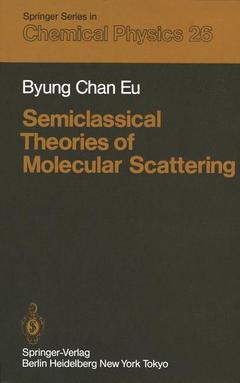Semiclassical Theories of Molecular Scattering, Softcover reprint of the original 1st ed. 1984 Coll. Springer Series in Chemical Physics, Vol. 26
Langue : Français
Auteur : Eu B. C.

The study of molecular collisions at energies from less than about 100 eV 3 down to a few 10- eV, which is roughly the range of chemical interest, has greatly expanded in the last 10 to 20 years. As in many fields, this activity has been stimulated by parallel advances in theory which have triggered the autocatalytic positive feedback system of experiment challenging theory and vice versa. Possibly the biggest driving force, however, has been the growing awareness that molecular collisions are important in our understanding of na tural and man-made environments. Molecular collision dynamics is now studied in connection with molecular formation in interplanetary space, upper atmo sphere chemistry, plasmas, lasers and fusion reactors, and is crucial for understanding gas-dynamic flow processes, gas-phase chemical reactions and catalysis. Despite the great strides made in studying elementary collisions in laboratory scattering experiments, many of the processes in these areas are too complicated for us to hope ever to study them in detail in the labo ratory. Thus in the long run we shall have to rely on theory. Initially, I think many of us, like myself, had hoped that the development of fast compu ters would outpace the demands on computing time so that "brute force" quan tum-mechanical exact calculations would provide all the answers. Unfortunate ly this has not been the case and efficient approximations are needed. They can be broadly classified as classical, semiclassical or semiquantal.
1. Introduction.- 2. Mathematical Preparation and Rules of Tracing.- 2.1 Asymptotic Expansion.- 2.2 The Stokes Phenomenon.- 2.3 The Stokes Phenomenon Continued: The Airy Functions.- 2.4 The Rules of Tracing.- 3. Scattering Theory of Atoms and Molecules.- 3.1 Time-Dependent Scattering Theory.- 3.2 Time-Independent Scattering Theory.- 4. Elastic Scattering.- 4.1 The WKB Approximation for Phase Shifts.- 4.2 Corrections to the WKB Phase Shifts.- 4.3 The WKB Phase Shifts at Low Energies.- 4.4 Semiclassical Approximation of Scattering Amplitude.- 5. Inelastic Scattering: Coupled-State Approach.- 5.1 Primitive Adiabatic WKB Wave Functions.- 5.2 The Uniform Semiclassical Method.- 5.3 The Semiclassical Scattering Matrix Elements.- 5.4 The Diabatic-Representation Approach.- 6. Inelastic Scattering: Time-Dependent Approach.- 6.1 Canonical and Unitary Transformations.- 6.2 Time-Dependent Semiclassical Theory.- 6.3 The Feynman Path Integral Approach.- 6.4 The Asymptotic Evaluation of the Semiclassical S Matrix.- 7. Curve-Crossing Problems. I.- 7.1 The Landau-Zener-Stückel berg Theory.- 7.2 Applications of the Uniform Semiclassical Theories.- 7.3 The Diabatic Representation Approach.- 8. Curve-Crossing Problems. II: Multistate Models.- 8.1 Multichannel Curve-Crossing Problems.- 8.2 The Case of n > 3.- 9. Curve-Crossing Problems. III: Predissociations.- 9.1 A Two-State Model.- 9.2 Modified Magnus Approximation.- 9.3 A Multistate Model for Predissociation.- 10. A Multisurface Scattering Theory.- 10.1 Multisurface WKB Solutions.- 10.2 Multisurface Scattering Theory.- 11. Scattering off an Ellipsoidal Particle: The WKB Approximation.- 11.1 Elastic Scattering off an Ellipsoid.- 11.2 The WKB Approximation.- 11.3 Elastic Scattering by a Potential.- 11.4 The WKB Approximation for SpheroidalHarmonics.- 11.5 Accuracy of the Uniform WKB Approximation.- 11.6 Inelastic Scattering.- 12. Concluding Remarks.- Appendix 1: Asymptotic Forms for Parabolic Cylinder Functions.- Commonly Used Symbols.- References.- Author Index.
Date de parution : 04-2012
Ouvrage de 232 p.
15.5x23.5 cm
Thème de Semiclassical Theories of Molecular Scattering :
Mots-clés :
Molekularer Stoss; Streuung; Theories; WKB-Methode; collision; scattering
© 2024 LAVOISIER S.A.S.



